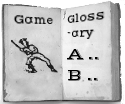Cat i’ The Hole
| Game | Cat i’ The Hole |
|---|---|
| Game Family | Kickball |
| Location | Scotland |
| Regions | |
| Eras | Predecessor |
| Invented | No |
| Tags | |
| Description | per Brand and Jamieson. All but one player stands by a hole, holding a stick [called a “cat.”] The last player, holding a ball, gives a signal, and the others run to place their stick in the next adjacent hole before a ball enters it, or he will become the thrower. Gomme specifies that when before thrower tosses the ball, he gives a sign and all the (boy) players must scramble to a neighbor's hole to obstruct the ball from entering it. Her c. 1894 description: "A game well known in Fife (a county northeast of Edinburgh on the Firth of Forth), and perhaps in other countries. If seven boys are to play, six holes are made a certain distances. Each of the six stands at a hole, with a short stick in his hand; the seventh stands at a certain distance holding a ball. When he gives the word, or makes the sign agreed upon, all the six change holes, each running to his neighbour's hole, and putting his stick in the hole which he has newly seized. In making this change, the boy who has the ball, tries to put in into an empty hole. If he succeeds in this, the boy who had not his stick (for the cat is the Cat) in the hole to which he had run is put out, and must take the ball. There is often a very keen contest whether one will get his stick, and the other the ball, or Cat, first put into the hole. When the Cat is in the hole, it is against the laws of the game to put the ball into it -- Jamieson Kelly, in his Scottish Proverbs p. 325, says" 'Tine cat, tine game:' an allusion to a play called 'Cat i' the Hole', and the English 'Kit-cat.' Spoken when man at law have lost their principal evidence." [Originally published in 1721.] |
| Sources | Brand, Observations on the Popular Antiquities of Great Britain: The Origins of Our Vulgar and Provincial Customs, Ceremonies and Superstitions., page 408. J. Jamieson, Etymological Dictionary of the Scottish Language (Edinburgh, 1825), page 192. Jamiesson describes the game as being played in County Fife and perhaps elsewhere. Alice Bertha Gomme, The Traditional Games of England, Scotland, and Ireland (London, D. Nutt, 1894), pages 63-64.
|
| Source Image | [[Image:|left|thumb]] |
| Comment | Edit with form to add a comment |
| Query | Edit with form to add a query |
| Has Supplemental Text |
Comments
<comments voting="Plus" />
